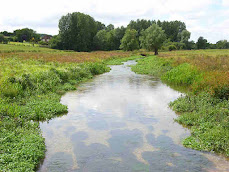The Lambourn Valley & The Wessex Downs

Link to GPX File of the Route This ride takes you from Newbury into the green valley of the River Lambourn, a classic chalk stream, which starts near Lambourn village and joins the Kennet in Newbury. At Great Shefford it turns north and climbs towards the open, arable, upland of the North Wessex Downs. You then have a 7 mile roller coaster ride along the hilltops with great views, before returning downhill back to Newbury, passing through villages set in the more wooded terrain of the lower lower eastern slopes. This peaceful countryside has been settled for millennia and vestiges of the inhabitants and their farming, from the bronze age through medieval times to the Victorians, can still be found. It is all on roads which, outside of busy Newbury, are small and quiet. Highlights are: The watermills and (probably!) medieval water meadows of the Lambourn, a classic chalk country stream. Creating and maintaining these is more complicated than you might imagine. ...


